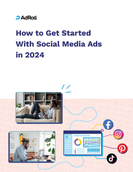The Power and Limits of Influencer Marketing: Understanding User Preferences and the De-Influence Trend

Brands have more power and tools to reach their customers than ever before. Whether you use a digital marketing platform to handle your paid ad campaigns or focus on the benefits of organic social media, you should know about every available tactic in your kit. That includes influencer marketing.
The use of influencers to evangelize and promote brands is a common strategy, especially in the tech, beauty, and fashion verticals. Companies add influencer marketing to their portfolio because it can be a cost-effective form of outreach.
That said, influencer marketing effectiveness varies by industry. It can add a layer of authenticity to your promotional efforts, but it’s a careful balancing act. There are always new trends to consider, including the increasing prominence of de-influencing — or highlighting products to avoid — in content creation. Companies need to be smart about how and when they deploy influencer campaigns as part of their strategy.
Let’s look at the power of influencers and how they can impact your brand’s social media advertising strategy. To do this, we surveyed users on their social media ad preferences with an eye toward answering two questions:
- How much stock do social media users really have in influencer recommendations?
- How do influencer marketing campaigns stack up against overt advertising?
The Power of Influencers
Influencer marketing involves partnering with people with a strong social media presence on platforms like Instagram, YouTube, TikTok, and Snapchat. Many companies use influencer marketing to increase brand awareness, content engagement, and sales. They accomplish these goals through:
- Product endorsements
- Recommendations
- Highlighting products or services in creative ways
Influencers typically fall under different categories. These can include:
- Mega-influencers: Mega-influencers have substantial social media followings, sometimes millions of followers. Think public figures and celebrities.
- Macro-influencers: Macro-influencers like Amy Jackson (fashion) and Peyton Pratte (cooking) usually have between 100,000 and 1 million social media followers across several platforms. They’re typically niche or industry experts, but not quite as well-known as mega-influencers. They can be cost-effective compared with other influencers.
- Micro-influencers: This type of influencer usually has between 1,000 and 50,000 collective followers on different platforms. They’re often popular in their local area or specialized niche. Micro-influencers are generally less expensive than other influencers and can offer highly targeted recommendations to their small group of followers. Popular micro-influencers include fashion and lifestyle blogger Karla Cristina and beauty influencer Caroll Salazar.
- Nano-influencers: Nano-influencers have smaller audiences, but those audiences are typically incredibly engaged. These influencers are a perfect fit for brands targeting a niche that not even micro-influencers can touch, such as foodies who review restaurants specific to a neighborhood or city. They bring unique insights about products or services based on their own experiences. This makes nano-influencers a fantastic partner for brands seeking authentic feedback from real consumers.
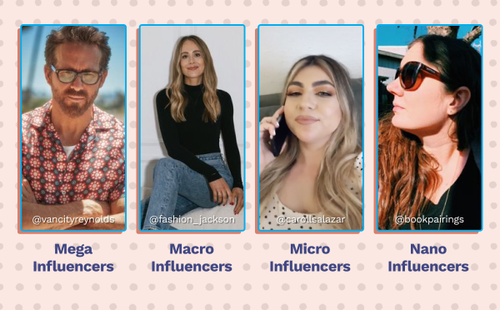
Read More: A Beginner’s Guide to Creating a Micro-influencer Campaign
No matter which kind of influencer your brand wants to partner with, keep one thing in mind: Influencer marketing isn’t a separate strategy from your social media marketing. It’s an integral way to build relationships and connect with customers.
De-influencing: What Is It, and Why Are Influencers Doing It?
Of course, not all influencers spend their time pushing products or services. De-influencing has emerged as a recent trend on TikTok and other video platforms where creators encourage people not to buy things.
But what’s causing this trend? Here are a few potential reasons for its growth:
- Users want to expose others’ lack of credibility.
- Gen Z social media users want to reclaim their buying power.
- Some influencers want to fight against a culture of overconsumption.
- Increased views: #deinfluencing videos have been watched over 300 million cumulative times.
What does de-influencing look like in the wild? It could be a gaming influencer discussing what products they don’t recommend or Sephora workers revealing which products don’t live up to the hype.
De-influencing continues to gain momentum as a trend. As people become more aware of the potential negatives of influencer culture, they’re rebelling against things like unrealistic beauty expectations and rampant consumerism.
What does that mean for your brand?
Companies that use influencer-heavy marketing tactics may need to think more carefully about their partnerships. That includes being more selective about who they partner with.
Effective marketing strategies avoid putting all your eggs in one basket. Balancing ads, user-generated content (UGC), and influencer marketing allows companies to reach the right audience and influence purchasing behaviors for their key demographics.
Need proof? We surveyed 1,000 individuals about their social media preferences, including influencer content. Let’s dig into survey results that gauge consumer preferences between overt paid social media ads and influencer marketing campaigns.
People Can’t Escape the Influence of Social Media
It’s not surprising that people can’t escape the influence of social media, especially when it comes to making purchases. What might pique your interest is that younger men are particularly susceptible to social media advertising. Men between 18 and 34 years old admitted that social media has influenced most online purchases.
As it turns out, Millennials are the most common online shoppers — 24.87% of adults in this age range say they shop once a week. Younger survey respondents between 18 and 24 only click to buy a few times a year.
- Females 18 – 34 admitted that social media has influenced some of their online purchases (58%).
- While males of the same age range mostly aligned with the statement that social media has influenced MOST of their online purchases.
- Only 11.42% of all surveyed claimed that social media has never influenced their online purchases.
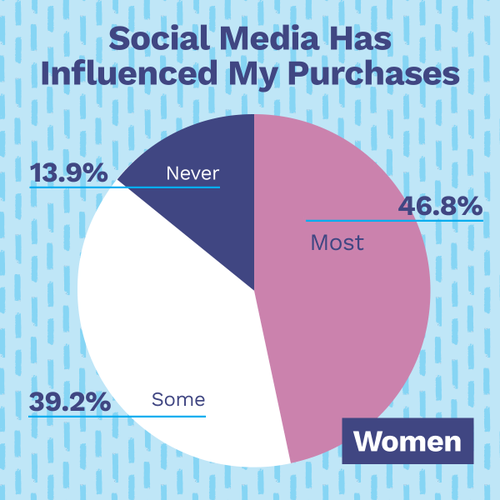
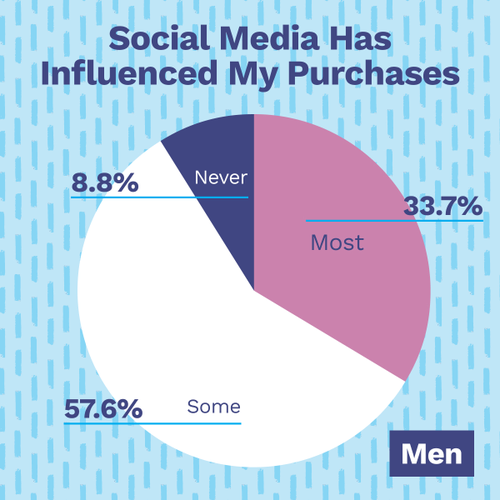
Individuals Are Stuck on Social and Consuming Influencer Content
Social media remains an attractive way to reach consumers because social media users are often a captive audience. Nine in 10 individuals are on social, and 83% of those users have made online purchases within the last year.
Facebook is the preferred social media platform for most survey respondents, with 86% saying they actively use it. Instagram (62%) and Twitter (44%) are second and third, respectively. If you’re considering ways to improve your advertising, remember that engaging visual content seems to do better than text posts alone.
Enthusiasm for platforms also differs along gender lines. Among our 18- to 24-year-old cohort, 80% of male respondents prefer Instagram. 95% of our surveyed group voted TikTok as their most-used platform. Since de-influencing is a major movement on the latter app, you may want to adjust ad spend and influencer budgets for these groups accordingly.
Read More: Curious about the cost of social media ads on different platforms? Get the average cost breakdown in our guide.
Influencing the De-influence Trend
How effective are influencers on social media specifically? About 80% of our survey respondents between 18 and 44 admitted to following influencers. In that same group, almost 82% admitted they’d purchased something based on an influencer’s posts.
As people become more aware of the adverse effects of influencer culture (unrealistic standards, materialism, etc.), companies need to know the difference between paid social and organic social media marketing (including influencer campaigns). This can help shore up any gaps in the marketing strategy that result from de-influencing campaigns.
Because influencers currently command a high level of authority when recommending products, the last thing an influencer-endorsed brand wants is to get hit with accusations of poor-quality products. By avoiding these associations, brands reduce the chances of being the target of a de-influence post or video. That said, it’s important to work with influencers who are a good fit for your product and have a reputation for authenticity in their communities and subcultures.
How Powerful is the De-influencing Movement on TikTok?
Influencers are reducing the amount of product promotion they’re engaging in because de-influencing content gets views.
The massive increase in views for de-influencing content tracks with what we heard from our survey. Non-influencer content resonated with our surveyed groups more, especially when it came to categories like software, subscription meals, and home goods.
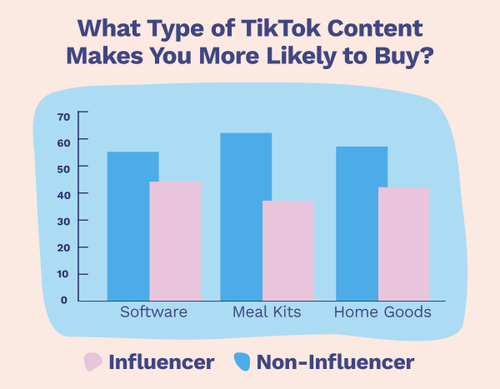
Influencer Marketing vs. Facebook Ads
Facebook users are growing tired of influencer content, too. We asked respondents about their preferences regarding four key product categories: software, lifestyle, pet, and beauty products/services. When shown non-influencer Facebook ads and influencer-produced content, they preferred the ads themselves instead of the more organic-like influencer posts.
In fact, beauty brands are the only category where influencer content still reigns supreme. That might be because a majority of consumers prefer influencers who closely resemble them (that is, everyday people) as opposed to celebrities, who are a staple of traditional paid TV ads.
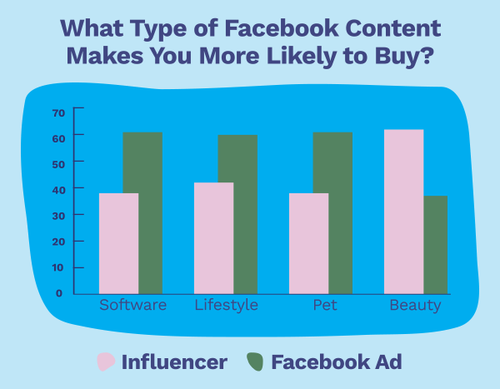
Influencers and Instagram Ads
Something unique happens when you ask people about their Instagram preferences. While people dislike influencer culture, they prefer the aesthetic of the influencer ad to more intrusive ad content. When shown videos about clothing brands, two-thirds of our surveyed users chose influencers’ Instagram Reels content versus non-influencer ads. That preference is borne out in data, too: Accounts with fewer than 5,000 followers see the highest engagement rates.
At This Point, You May Be Asking: Are Social Media Influencers Effective?
There’s a reason influencers’ adoption of de-influencing tactics has become a trend — they’re still influencers, after all. Even when telling someone not to buy something, their audiences will listen.
Why are people still listening to influencers even when there’s a sense of fatigue surrounding the culture? As it turns out, tone is essential.
We asked our surveyed groups whether they liked when brands or influencers spoke directly to them or, instead, focused on the product. Most users (55.26%) reported preferring when influencers speak directly to them rather than strictly focusing on the product.
This likely has to do with the fact that the best examples of influencer content feel like word-of-mouth recommendations as opposed to ads. It’s a lot easier to take advice from someone who presents it in a conversational, unforced manner.
Social Media Marketing With Influencers for Maximum Effect
The question ultimately isn’t whether you should use influencer marketing versus paid ads on social media. It’s how you can mix and match those campaigns for maximum effectiveness.
Whether influencer campaigns fit neatly in your marketing matrix is unique to your business. Authenticity and building a community around your brand are often more helpful than splashy paid endorsements. Work with influencers who share your priorities and are well-regarded by their desired audience. This can reduce the risk of becoming a victim of de-influence content.
In addition to using influencer content, exploring other marketing avenues is worthwhile. Knowing when and how to deploy social media ads, organic social media messaging, and even retargeting ads for users who have already visited your site go a long way toward a comprehensive strategy.
Maximize Your Marketing Strategies
With AdRoll, you can maximize the potential of your web and social media ad campaigns. From audience and segmentation tools to retargeting ads, our platform can help simplify the process of promoting your business.
Learn more about how AdRoll can improve campaign effectiveness with less time and effort here.
